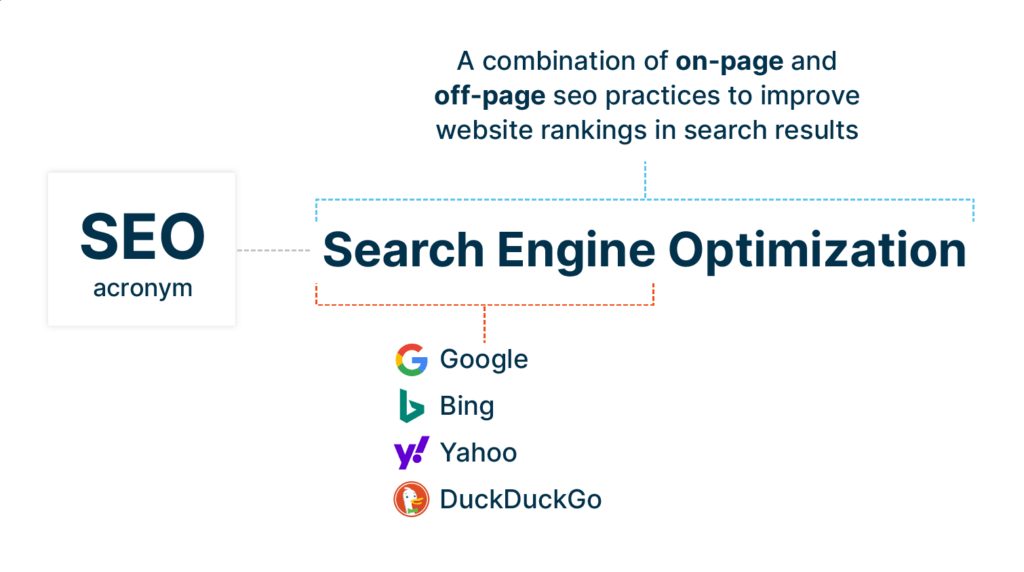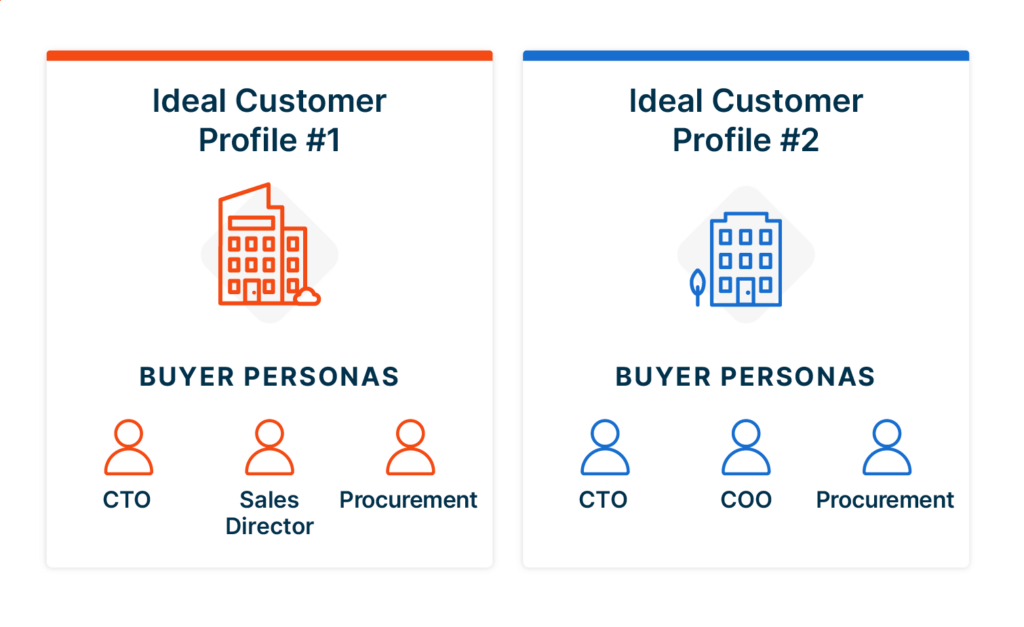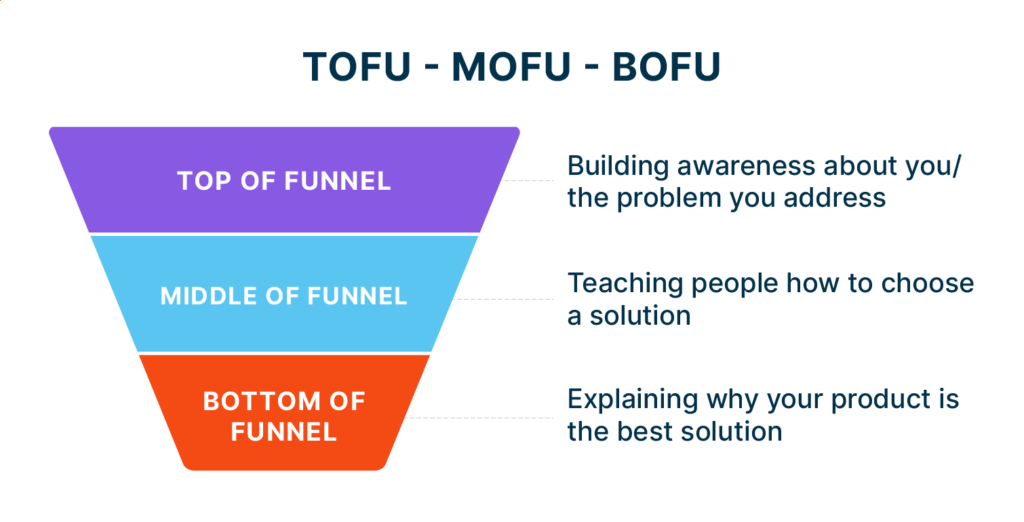We’ve all been there—you hear someone using an acronym that you’re guessing you should know, but don’t. When this happens in professional settings, it can be stressful as you work to quickly get up to speed and catch up with the conversation.
Given the number of marketing acronyms that exist today, it’s no surprise that even the most savvy marketing professionals are sometimes caught off guard.
In this guide, we’ll explore why marketing and sales acronyms are so prevalent in the business world today, then walk through some of the most important ones to know and understand.
Quick Takeaways
- Marketing acronyms are abbreviations that describe a marketing tool, process, or metric
- Knowing marketing acronyms helps professionals seamlessly navigate business conversations and communicate more effectively with colleagues and clients
- SEO is a key acronym to understand for executing a strong content marketing strategy
- MQL and SQL as well as ToFu, MoFu, and BoFu are critical to effective lead management
- CX and UX are now rated the most important factors in a purchase decision—above both product and price
- Other important marketing acronyms to know include CRM, KPI, ICP, and CTA.
What Are Marketing Acronyms—and Why Are There So Many?
A marketing acronym is an abbreviation formed from the first letters of a multi-word term that describes a marketing tool, process, metric, and so on. For example—the search engine optimization process is referred to as SEO, and customer relationship management systems are called CRMs.

Over time, marketing acronyms are often used so much that they nearly completely replace the original term itself in communications—and today, new technologies are emerging and marketing methods are evolving so quickly that new acronyms are popping up all the time. For marketers and sales teams, it can feel impossible to keep up with!
But the truth is that we need marketing acronyms to make communication more practical in every part of the marketing world, from emails, chats, and trade shows to webinars, blogs, and other types of published content.
Otherwise, we’d be tongue-tied saying things like “key performance indicators” and “conversion rate optimization” over and over, and written content would be repetitive and hard to read.
While you may not be able to remember every marketing acronym by memory, there are some that every marketing and sales professional should be able to use with confidence. Let’s explore 14 of these acronyms and why they’re so critical to know.
14 Marketing Acronyms Every Marketer Should Know
What is meant by B2B and B2C?
B2B and B2C stand for business to business and business to consumer. These acronyms refer to who a company is selling to—another business or an individual buyer.
Sales best practices and buyer needs vary greatly across B2B and B2C sales environments, as do the specific methods companies use to generate leads and engage customers. Whether you’re researching for your own strategy or advising clients on theirs, it’s important to know these key differences and how to discuss them.
What is SEO?
SEO stands for search engine optimization. It’s a core component of content marketing, which is
now used by more than 80% of all companies has shown to earn 6x the conversions of other marketing tactics.
At the core of successful content marketing is SEO—search engine optimization. It’s the process of identifying how a relevant audience is searching for your products and services, creating content across many mediums that answers the questions they’re asking, measuring the results, and continuously refining based on data—wash, rinse, repeat.
the process of designing your website and content to drive traffic from search engines. Specifically, it aligns content with the keywords and search terms a target audience is using to find brands, products, and solutions.
Given that 93% of all online experiences now begin with search, knowing what SEO is and how to talk about it is essential for every marketing team in every company and industry.

What is CRM?
CRM refers to customer relationship management systems, used by companies in the B2B sector to track and manage leads across the pipeline. They drive big business benefits like greater pipeline visibility, real-time lead tracking, and data analytics that help companies refine their marketing and sales processes.
Professionals today need to know what a CRM is and how theirs works in order to optimize lead generation and successfully manage leads as they move through the pipeline to final sale.
What are KPIs?
KPIs are key performance indicators—quantifiable metrics that help companies track their progress toward a goal. It’s important to know both what KPI means as well as actual KPIs that have their own separate marketing acronyms, such as:
- Customer acquisition cost (CAC)
- Conversion rate (CR)
- Customer retention rate (CRR)
- Cost per lead (CPL)
- Click-through rate (CTR)
What are OKRs?
OKRs are objectives and key results, and like KPIs, they help companies track how well they’re moving toward a specific goal. Unlike KPIs, however, they focus less on metrics and more on defined outcomes. For example—“Our company will achieve [X goal] as defined by [Y result].”
OKRs are generally considered to be a more flexible framework, and one that allows you to look comprehensively (rather than strictly quantifiably) at the end result you want to achieve.
Given that not every goal can be measured numerically, OKRs are important to have in your arsenal as a way to recognize progress and accomplishments. And while debate is often hot in the business world around which is better—KPIs or OKRs—the smartest companies are using both to measure performance in a more holistic way.
What are CX and UX?
CX and UX are short for customer experience and user experience. They’re two of the most critical factors in a B2B purchase decision—Gartner ranks CX and UX above both product and price in buyer importance.
CX and UX are sometimes used interchangeably, but while they’re similar, they do have separate definitions and the distinction is important to know.
Customer experience refers to any and all interactions with your brand and could be applied to many people—purchase decision makers doing purchase research, executives approving the final choice, implementation partners, product users (and the list could go on).
On the other hand, user experience refers fairly exclusively to the end product user—the people in an organization actually interacting with the product you sell.
For example: An SaaS company selling email marketing software may interact with IT leaders, marketing managers, executives, and administrative teams who help execute the purchase. The customer experience would include all of these interactions and people.
The user experience, however, would stay focused on the actual marketing professionals who use the product in their everyday work.
What are CTAs?
CTAs are calls to action, and they direct potential buyers on what to do next. You’ll see CTAs in every kind of content, guiding audiences on the right action to move forward in the buyer journey. The most compelling CTAs you’ve likely seen often include “Click here to learn more!” or “Start your free trial today!” or “Contact our sales team to get started!”
What is an ICP?
ICP stands for ideal customer profile. It’s a framework used by B2B companies to identify best-fit potential customers by organizational traits—size, industry, location, budget and the like. They’re different but related to the more commonly-known and used buyer persona framework, which companies use to describe individual purchase decision makers.

What are MQLs and SQLs?
Sales qualification is a process for managing lead quality along the pipeline. Marketing qualified leads (MQLs) fit your ideal customer profile but aren’t quite ready for direct sales interactions. Sales qualified leads (SQLs) have purchase intent and are ready to be contacted by a sales rep.
Identifying your company’s MQL and SQL criteria is important for giving leads the right level of engagement and aligning content with their purchase readiness.
What do ToFu, MoFu, BoFu mean?
ToFu, MoFu, and BoFu are marketing acronyms to shorten the reference to stages of the marketing and sales funnel. They describe both leads themselves (i.e. “This communication is for BoFu leads”) as well as strategies themselves (“We need to improve our ToFu lead-gen to build a healthier pipeline).

Why Marketing Acronyms Really Matter
As a B2B seller, you should be positioned to your potential customers and industry peers as an expert in your field. Knowing the most commonly-used marketing acronyms and those most relevant to your role is critical to navigating daily business conversations and communicating in an effective way.
Further, knowing important marketing acronyms means you won’t be caught off guard or left guessing when they’re used by colleagues, clients, and/or at industry events.
Our list covers some of the acronyms we think are most important for professionals today, but we know there are many more out there being used!
What are the most important marketing acronyms you use in your work? If you think we missed one that should be in this article, let us know!
Invest in Quality Tech Content with ActualTech Media
ActualTech Media helps tech professionals make and disburse top-quality marketing content that resonates with unique goals and audiences. By partnering with our team, you can create engaging niche content for your tech industry audiences, then use our content syndication strategy to earn maximum ROI.
Contact us today to explore solutions that can help you achieve your marketing goals.